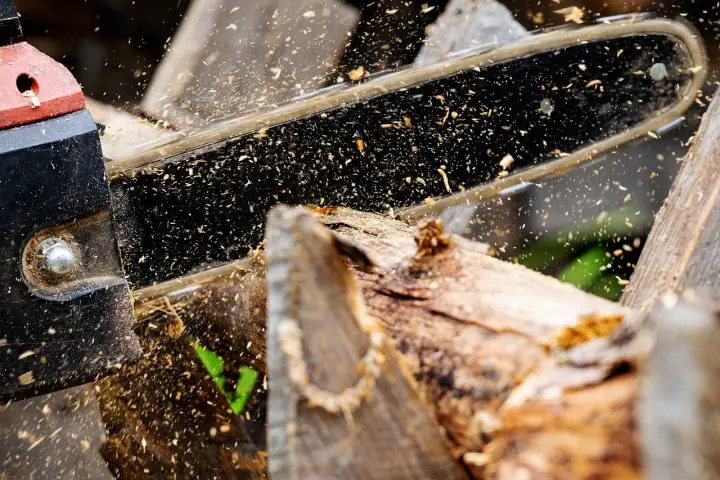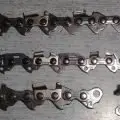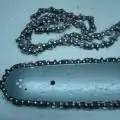Every so often, it becomes necessary to replace a chainsaw guide bar because it can become worn out or even destroyed while in use. Guide bars may occasionally need to be changed simply because you wish to alter the behavior of your saw by switching the bar for one that is longer, shorter, or has a different profile. The key question is whether chainsaw bars are interchangeable or not.
In this article, we’ll discuss how chainsaw bars are not interchangeable unless they have a matching bar mount type, are designed for the same chain pitch, and the chain and bar gauges match.
Table of Contents
- Are Chainsaw Bars Interchangeable?
- Are Same-Brand Chainsaw Bars Interchangeable?
- Which Chainsaw Bars Are Interchangeable?
- Choosing a Replacement Chainsaw Bar Considerations
- FAQs (Frequently Asked Questions)

Are Chainsaw Bars Interchangeable?
No, chainsaw bars are not universal. Instead, bars have unique, incompatible mounts that are exclusive to a certain type of chain. More specifically, chainsaw bars differ in terms of mount geometry, intended chain pitch, and gauge, all of which must be compatible with your particular saw and chain. You cannot just fit any bar on any saw as a result.
There are numerous mount types for chainsaw bars, the majority of which are incompatible with one another. Bars from other brands will rarely fit your saw because bar mounts are frequently brand-specific. Additionally, saw makers often use several mounts in their smaller and larger saws. For instance, Stihl utilizes three distinct mounts, while Husqvarna uses two, and neither pairs well together.
Typically, bars are produced for ten different chain pitch-gauge combinations. This indicates that there are many replacement bars available with the same design pitch and gauge as your original bar, but you must be careful to choose the correct one.
Are Same-Brand Chainsaw Bars Interchangeable?
Perhaps chainsaw bars would be at least within a specific chainsaw brand if they are not universal or interchangeable in general. Unfortunately, even within a brand, chainsaw bars are rarely totally interchangeable. The majority of chainsaw manufacturers employ two or more mounts and a variety of chain pitches in their saw lineup, which is the reason for this.
Which Chainsaw Bars Are Interchangeable?
Replacement bars that can be used interchangeably with the original bars must fit your saw and use the same kind of chain. There are three major aspects that influence compatibility:
- Bar mount
- Chain pitch
- Chain gauge
The above can be broken down in relation to the chain and the saw:
- A bar must have the same mount type and design chain pitch as your saw in order to fit it.
- A bar must have the same pitch and gauge as your chain in order to fit it; if using ready-made chain loops, the chain and bar lengths must also match.
Bar Mount Compatibility
For mounting to the saw body, the majority of chainsaw bars employ an apparently comparable configuration of slots and holes. Bar mount and tail mount are two names for this configuration. A guide bar and a saw powerhead must have the same bar mount type in order to function together.
Bar Mount Features
- The powerhead’s bar studs fit in the main slot. On the middle line of the bar, there is a lengthy slot that may be open at one end or closed at the other.
- Smaller, symmetrical chain tensioner holes are located on either side of the main slot. The chain tensioner pin is accepted by these.
- On either side of the bar sits a singular, tiny blind chain oiler hole. The chain oiler’s oil can pass through this hole, which is closer to the edge, and into the chain groove in the bar.
Although all chainsaw bars include these features, the size and location of each element vary between brands and within a given brand’s product ranges. Some mounts have a broad main slot while others are narrow; some have tensioner holes that are close to the main slot while others are farther away; some mounts even have several tensioner holes.
There are numerous unique bar mount types due to the various hole and slot combinations. Regrettably, minute variations render mounts incompatible: if the holes do not line up, the bar will not fit or function as intended. The majority of bar mounts are incompatible with one another as a result. The mount types must be the same, or at least fairly comparable, for a bar to fit your saw.
When a bar can be mounted to a different type of mount, there are a few good examples: replacement bar manufacturers like Cannon, Oregon, and Sugihara have created bars with a universal mount geometry that make them compatible with original bars that were mounted to a variety of mount types.
Additionally, a lot of mounts that aren’t always compatible can be combined utilizing mount adapters. You may buy these, for instance, from Cannon, or you can create a lot of them yourself with some simple machining.
Chain Pitch Compatibility
The length of the links in a chain is known as chain pitch. A guide bar, the chain, and the saw powerhead must all be made for the same chain pitch in order to work together. The nose sprocket in the guide bar and the driving sprocket (also known as a spur sprocket) in the saw powerhead are the two sprockets responsible for this. Because only one chain pitch fits both sprockets, the design chain pitch of the powerhead-bar-chain assembly must match.
There are approximately six standard chain pitches:
- 1/4”
- 1/4”P
- .325”
- 3/8”
- 3/8”P
- .404”
Small pitch chains are utilized in under 50 cc gas and battery-powered low-power saws; longer pitch chains are larger overall and are employed in larger and more potent saws.
Note: Pitch designations (sometimes Picco, sometimes LP, sometimes Mini) denote specific low-profile chains and bars. These chains and bars are incompatible with the standard 3/8″ or 1/4″ chains and bars, despite the fact that the actual pitch is the same.
Chain Gauge Compatibility
Chain gauge refers to the chain’s drive links’ thickness. The lowest portion of these links runs in a bar groove that is present on chainsaw bars. The chain links should snugly, but not overly tight, fit the groove. To do this, the nominal gauge of the bar and chain must be the same.
Four chain gauges are frequently used:
- .043”
- .050”
- .058”
- .063”
Similar to chain pitch, narrower gauges are found in smaller saws and larger gauges are used in large, high-power saws. The chain and bar gauges must match because each gauge requires a groove in the bar of a different width.
There are 24 different pitch-gauge combinations when there are four common gauges and six pitches; what a headache for compatibility! Only 9–10 pitch–gauge combinations are actually in use because, in practice, chain pitch and gauge work more or less hand in hand; they’re listed in the table below. You must pay close attention to how your bar and chain are fitted.
| Chain Pitch | Chain Gauges |
|---|---|
| 1/4P | .043” |
| 1/4” | .050” |
| 3/8P | .050” |
| .325” | .058” .063” |
| 3/8” | .050” .058” .063” |
| .404” | .063” |
Visit our Chainsaw Chain Sizes guide for more information on the different types of chains and sizes.
Choosing a Replacement Chainsaw Bar Considerations
Although there isn’t a chainsaw bar that will match every user’s needs on the market, you should always keep the following things in mind when purchasing a replacement chainsaw bar:
Bar Size
To purchase a replacement bar for your chainsaw, you shouldn’t just go into the closest chainsaw accessory store. Before submitting a purchase order, you must measure the size of your chainsaw bar. The caveat is that size does matter if you choose to purchase any bar to use with any chainsaw.
Before placing an order, always measure the width and length of any bar. Measure the size of the bar you want to replace as well, and if the replacement is the same size, you’ve discovered the ideal replacement.
Even with matching bar sizes, you are still not there. There are many additional factors to take into account when choosing the ideal replacement chainsaw bar.
Visit our How to Measure a Chainsaw Bar & Chain to learn the right way to do it!
Tension Hole, Oil Holes, and a Bolt Slot
The good news is that you have so far located a chainsaw bar that is a perfect match, but does it match in all other respects—including tension holes, oil holes, and bolt slots?
The chainsaw bar’s tension can be changed using the tension hole. A chainsaw attachment point is provided by a bolt slot. Check the oil openings that allow you to oil the chain as well. All the aforementioned attributes should be the same in a suitable replacement chainsaw bar that you are looking to purchase.
Both the tension hole and the bolt slots on the new bar should line up with the ones on the old chainsaw bar. You should be aware that some chainsaw bars feature auto-oiling functionality, but there are other factors to take into account.
The next stage is testing the item once you’ve done everything to make sure it qualifies as “a universal chainsaw bar.” Once you turn on your chainsaw, pay special notice to how the new bar acts. Having the greatest bar replacement for your machine is important.
Another important factor is the blade direction, visit our Chainsaw Chain and Blade Direction Guide to learn the correct way to fit a chain!
FAQs (Frequently Asked Questions)
Can I put a different bar on my chainsaw?
Up to three different bar sizes can often be used with chainsaws. The size of guide bars ranges from 14 to more than 40 inches, measured from the tip of the bar to the heel. To find out what size bars your saw can handle, check the specs in the operator’s manual for your model.
Do all chainsaw bars fit all chainsaws?
Sadly, chainsaw bars are not interchangeable. Each chainsaw bar is made to fit a certain model of chainsaws, and therefore cannot be used with any other models. Chainsaw type, chainsaw size, tensioner hole, bolt slot, and oil hole locations should all be taken into account when choosing a chainsaw bar.
Can you put a Husqvarna bar on a Stihl chainsaw?
Although Stihl and Husqvarna bars cannot be interchanged directly, they can be made compatible by the use of mount adapters or bar modifications. In general, it is frequently simpler to adapt Stihl bars to Husqvarna saws than the other way around, however, this relies on the precise sort of mount that the bar and saw utilize.
How do I find the right bar for my chainsaw?
You should first refer to your user’s manual for the recommended chainsaw bar for your chainsaw, or contact the manufacturer directly for advice. Otherwise, you can measure your chainsaw bar. Do this from its front tip all the way back to the cutter that is closest to the saw’s body to determine its called bar length. This measurement should be rounded up to the next even number of inches. For instance, a bar that is truly 18 3/4″ long will be labeled 20″.





